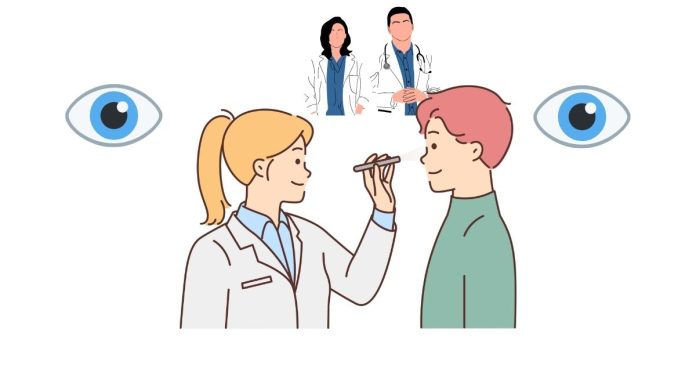The medical abbreviation EOMI stands for “Extraocular Movements Intact.” It is a term commonly used by healthcare providers, particularly in the context of physical examinations, to describe the movement and function of the eyes.
Understanding the Term
- Extraocular Movements (EOMs): These refer to the movements of the eyes that are controlled by six muscles that surround each eye. These muscles allow the eyes to move in all directions: up, down, left, right, and diagonally.
- Intact: The word “intact” in this context means that these movements are normal, complete, and functioning as expected. It implies that the muscles controlling eye movements are working properly, and there is no evidence of weakness, paralysis, or abnormality in the eye’s movement.
Context in Medical Examinations
When a healthcare provider notes EOMI in a medical record or during a physical exam, it usually indicates that the patient’s extraocular muscles are functioning properly. It is often part of a routine examination, especially during an eye or neurological assessment.
- Physical Examination of the Eyes: During a physical exam, the doctor may ask the patient to follow a moving object (like a pen or finger) with their eyes to observe the smoothness and coordination of eye movements. If the patient can track the object in all directions without any difficulties, the provider may note that EOMI are intact.
- Neurological Assessments: Since the control of eye movements involves both the brain and the muscles around the eyes, noting EOMI is important in neurological exams. If there is any dysfunction in the brain or nervous system, it may affect the eyes’ ability to move properly. For example, abnormalities in extraocular movements may suggest a neurological disorder, such as a stroke or a cranial nerve injury.
What It Indicates in Terms of Health
When a medical provider documents EOMI, it typically suggests the following:
- No Signs of Neurological Issues: The intactness of extraocular movements suggests that there are no apparent neurological deficits that would affect the movement of the eyes. It indicates that the brain regions controlling eye movements (such as the cranial nerves) are functioning normally.
- No Muscle Weakness or Paralysis: Since extraocular movements involve muscles, a notation of “intact” means there is no weakness, paralysis, or abnormal movement in the eye muscles. This could rule out conditions like strabismus (misalignment of the eyes) or ptosis (drooping eyelid).
- Normal Eye Function: EOMI suggests that the eye muscles are performing their function correctly, and the patient does not have issues with eye coordination or eye strain due to muscle problems.
Conditions Where EOMI May Be Abnormal
If the extraocular movements were not intact (i.e., if EOMI were abnormal), it could point to various medical conditions, such as:
- Cranial Nerve Palsies: The nerves that control the eye muscles (cranial nerves III, IV, and VI) may be affected by conditions such as stroke, aneurysm, or trauma, leading to abnormal eye movements.
- Strabismus: This is a condition where the eyes do not align properly and may lead to difficulty in moving the eyes together in the same direction. This can cause issues such as double vision.
- Multiple Sclerosis: This neurological condition can affect the eye muscles, leading to abnormal or impaired eye movement.
- Thyroid Eye Disease (Graves’ Disease): This condition, often associated with thyroid dysfunction, can cause inflammation of the muscles around the eyes, affecting the ability of the eyes to move properly.
- Brain Tumors or Lesions: A mass or tumor pressing on areas of the brain responsible for eye movement control can lead to abnormal EOMs.
- Myasthenia Gravis: This is a condition that causes muscle weakness, including the muscles controlling eye movement, potentially leading to issues with eye movement coordination.
How EOMI Is Checked in a Physical Exam
To test for extraocular movements, a doctor will typically perform a simple exam called the “H” test or “six cardinal directions of gaze” test:
- The doctor asks the patient to keep their head still.
- The patient is then asked to follow the doctor’s finger or an object as it moves in various directions — up, down, left, right, and diagonally (forming an “H” pattern).
- The doctor observes if the eyes move smoothly and equally in all directions.
If the movements are smooth and both eyes track in unison, the examiner will note that EOMI is intact. If the patient struggles with certain movements, has double vision, or their eyes fail to move together properly, it may indicate a problem with the eye muscles or the nervous system.
Conclusion
EOMI (Extraocular Movements Intact) is a medical term indicating that a patient’s eye movements are normal, smooth, and coordinated. It is often used as part of a routine physical examination to assess the function of the extraocular muscles and the neurological pathways that control them. When EOMI is documented as intact, it generally means there are no issues with the muscles or nerves that control eye movements. Conversely, abnormal findings in extraocular movements could signal a range of underlying medical conditions, particularly those involving the brain, nerves, or eye muscles.


